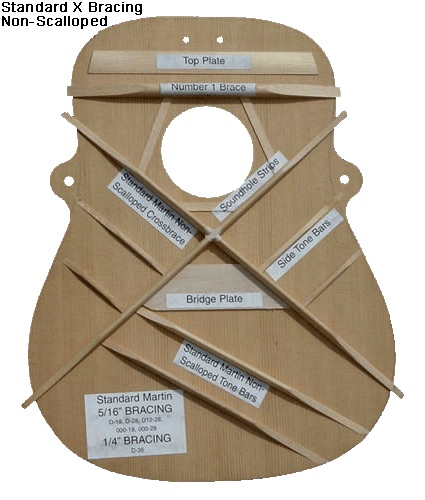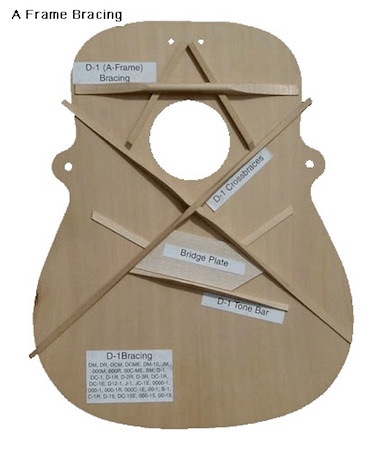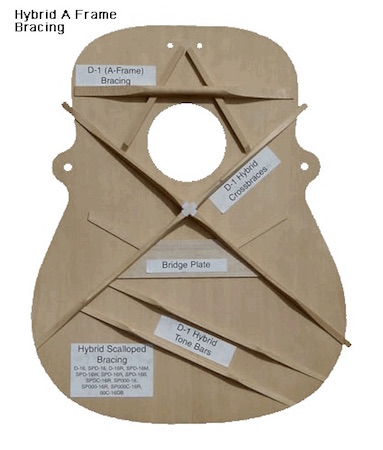This week I wanted to talk about an aspect of an acoustic guitar's sound that gets brought up to me a lot by customers, Guitar Bracing. The terms "Scalloped" or "X braced" get thrown around a lot on acoustic guitar forums and in conversation but sometimes it can be a little hazy as to what these things actually mean to the sound of your guitar.
What is bracing?
Braces are the framework upon which a guitar is built. When we think about acoustic it's easy to think of only what's showing. What tone woods does it have? What does the neck feel like? And while these external factors are important they are not the whole picture. A guitar's bracing is one of the most defining factors in the overall tone of the instrument. While bracing can come in an almost unlimited variety depending on the make and model of a guitar.
All luthiers have to take the same two variables into account and balance them carefully: durability and tone.
Durability is pretty self explanatory. Acoustic guitar bodies are inherently going to have a lot of stress put on them by the steel strings we use. From the day it leaves the factory a Martin instrument has upwards of 200lbs of force pulling on neck and body, 24 hours a day, 7 days a week. The only thing keeping the entire instrument from folding in half are the carefully designed braces inside of each instrument, put there to reinforce the top, back and sides of the instrument and give it the rigidity it needs to stand up to this tension for decades.
If all a luthier had to worry about was durability, that would be the end of the story. They'd be able to glue a few pieces of 2x4 underneath the the guitar's top and call it a day. But of course this isn't the case. The tone of an instrument is created by the vibration of the body. The more easily a guitar can vibrate the louder it's going to be and the more bass response it's going to have. So while for durability's sake you'd want to have as much bracing as possible, for a freely moving instrument you'd want to have as little as possible. It's the luthiers job to balance both of these considerations, building a guitar with as little bracing as possible without sacrificing it's structural integrity.
Martin bracing styles : X, A and Hybrid

Undoubtedly the most popular bracing pattern Martin uses is their 'X' bracing. Found on the majority of Martin instruments, the X bracing was first developed in the 1850s. This 'X' bracing took the place of the more traditional fan bracing used by European guitar builders at the time. While maybe not as ideal for the gut strings used during this period, as the market changed and players started demanding louder instruments, Martin's sturdier 'X' bracing allowed for an easier transition to the higher tension steel strings necessary to achieve that. X Bracing is used on all of Martin's guitars that feature hand cut dovetail neck joints.
X bracing gets its name from the prominent 'X' formed by the two cross braces just below the soundhole of the guitar. Around this X you'll find 6 Tone Bars, two on each side of the X and two much larger ones below it. Another thing to note is that, above the Number 1 Brace you'll find a Top Plate, also commonly known as a Popsicle brace. This plate is a purely a structural support. Originally found on older 12-Fret Martin bodies when the first 14-Fret guitars were made this brace was removed. However, because it's removal often lead to tops splitting near the fretboard Martin has since replaced the Top Plate on almost all of their X Braced guitars.

A Frame bracing is used on guitars with a Mortise/Tenon. As you can see, on an A Frame guitar the horizontal Top Plate (a.k.a. the Popsicle brace) is removed and instead two angled strips are used. These strips, along with the Number 1 brace make a shape similar to the letter A, hence the name. What's unique about A Frame bracing is that these two strips actually fit into a specially made notch in the guitar's neck. This is done to give more stability and support to the neck. If you look below the soundhole you'll see that the A Frame pattern has a lot less bracing under the lower bout of the instrument. The reason for this is that Martin, by angling the bridge plate and bordering it with a tone bar, essentially created a very strong box, giving the instrument the rigidity it needs without needing multiple longer tone bars.

Hybrid X bracing, also known as Hybrid A Frame Bracing, is a blending of A Frame and X features and is also found on Mortis/Tenon instruments. This pattern is also sometimes referred to as Hybrid A Frame bracing, although this is much less common. No matter what you call it, Martin's Hybrid bracing retains the A shape and the lack of side tone bars from the A Frame bracing pattern while also utilizing the same tone bars placement below the bridge plate as is found on an X braced guitar. I always tend to think of it simply as "The top half is A Frame, the Bottom half is X".
It's hard to pinpoint exactly what the tonal differences between the regular X bracing and A Frame bracing patterns are. This is because there really isn't a situation where all else is equal except for the bracing style. If you look at it on paper it seems like the A Frame bracing, with its fewer tone bars on the lower bout would move more easily than an X braced guitar and therefor give more bass. It's been my experience that A frame guitars actually have a weaker bass. They tend to sound a little tighter and are just generally less responsive. Whether this is the fault of the bracing or a different variable is hard to say just showing once again that it's never about just one piece of the instrument but about how all of the pieces work together.
Scalloped or straight? Or maybe forward shifted?

The profile of a Non-Scalloped "Straight" brace.

The profile of a Scalloped brace.
When talking about bracing the thing that people seem most curious about are Scalloped braces. Scalloped bracing is when the luthier removes parts of the braces giving them a "scooped out" appearance. The purpose of this is to reduce the mass of the bracing, allowing the top to vibrate more freely without sacrificing the structural integrity. Originally all Martin steel string instruments were scalloped. However, in the mid 1940s Martin transitioned to straight non-scalloped braces. This switch (Along with the change from Red/Adirondack Spruce tops Sitka Spruce) tends to be the point at which Martin collects declare the end of the "Golden Era". This practice of only using straight braces continued until 1977 when Martin released the HD-28, a dreadnought guitar that featured braces scalloped similar to those in the found in the Pre-War, "Golden Era" instruments. Since this point Martin has released many other scalloped guitars and once again the Scalloped instruments have become a fan favorite of sorts, outselling their straight braced counterparts.
In terms of sound, scalloping braces give a guitar a stronger bass response. This is why it's become so popular on Dreadnought models size that lends itself to low frequencies particularly well. But does this make scalloped guitars better than straight braced guitars? I've always felt and try to stress when I'm talking about acoustic instruments that no one feature defines a guitar. Whether or not the braces are scalloped is just one of countless variables that influence the tone of a guitar. Because of this I think it's important for players to remember that a guitar is the sum of all of these variables and should therefor be judged as a whole.
This same principal applies to forward shifted instruments. As I mentioned in a previous Martin guitar comparison article, the standard position for the center of the 'X' (The point where the two Cross braces meet) is 1.5" below the soundhole. When a guitar is "forward shifted" this means that the center of this X is moved a half an inch closer to the soundhole. This forward shifting is meant to give more flexibility to the lower bout of the guitar and, like scalloped braces, give a better bass response. Forward shifting is generally only performed on Dreadnought sized guitars. Just as with the scalloped vs non-scalloped question, forward shifted braces are not inherently better than standard positioned ones, just different.
One quick note: Currently there is one Martin guitar, the D-28 Authentic 1941, that actually has rear-shifted bracing where the center of the X is 1-7/8". You can read more about my experiences with that model here.
For those of you who may have had questions regarding bracing, I hope this clears things up. While there are other aspects to acoustic guitar bracing such as brace thickness and "Golden Era" style bracing, these are better left for another day.
What are your opinions about guitar bracing? Do you have a preference for any particular style? Be sure to let us know in the comments below.